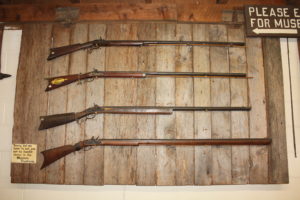
Above is a fine display of Southern Mountain Rifles at the Museum of Appalachia.
Mountain Gunsmiths and their Firearms
By: Robert Dunn
I have always been fascinated with old muzzleloaders and the gunsmiths that built them. Early vacations to Williamsburg, Virginia exposed me to master gunsmith Wallace Gusler, as well as the Gunsmith and Blacksmith shops in Colonial Williamsburg. The fact that a gun could be built by one man from start to finish has held my interest throughout my entire life. My Dad had a love for firearms and he was quite a craftsman himself, so I was also exposed to working with wood, metal and firearms from an early age. Though I have taken on some interesting Gunsmithing projects and have built some muzzle loading firearms from kits, I still have a long journey ahead to master these skills.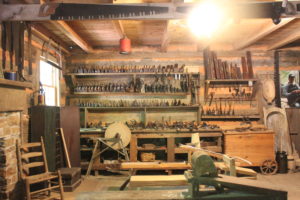
Here we can see many hand tools, a grinding wheel and shaving horses in the woodworker shop at the Foxfire museum.
While I was living in Georgia, my brother Bill and I had the chance to take a short vacation together. Our first stop was at the Foxfire Museum in Rabun County, Georgia. I grew up reading the Foxfire books and I was thrilled to visit the museum, which documents Southern Appalachian Mountain Heritage. Foxfire Volume 5 is the book you should read if you are interested in flintlocks and blacksmithing. There are a lot of woodworking tools such as shaving horses, planes, lathes and countless hand tools to be seen. There is also a blacksmith shop at the Foxfire Museum. I could picture the craftsmen from the past working to create many functional tools, such as a firearm and other works of art. After taking in the 106 acre museum in Georgia, we continued our journey straight into Tennessee. We spent the evening in Knoxville and got up early to make the short drive to Clinton to visit the Museum of Appalachia!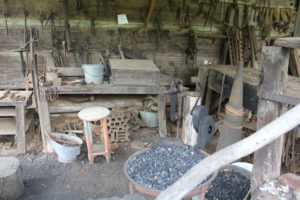
Here we get a view inside the Blacksmith Shop at the Museum of Appalachia.
I have literally been waiting to see the Museum of Appalachia for decades, as they have a wonderful display of firearms and Gunsmithing/building tools and machines. The gentleman who established the Museum of Appalachia, John Rice Irwin, also wrote a favorite book of mine, Guns and Gunmaking Tools of Southern Appalachia. Mr. Irwin has gathered a magnificent collection of tools that were used by various gun makers throughout Appalachia. There are also two blacksmithing shops on location, among so many other metal and woodworking tools it would be hard to list them all.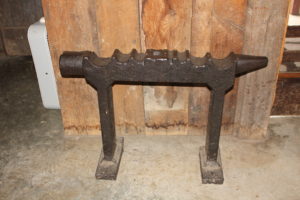
Here we can see an interesting Gun Anvil/Swage Block, used to form barrels, rods and various tools.
Our first stop was at the Blacksmith Shop, as the forge would be the place where the barrel was made. I could easily picture myself pounding red hot iron skelps fresh from the forge around a mandrel on a big gun anvil to form and weld the barrel. After much daydreaming about becoming an accomplished blacksmith, we wandered over to a structure called the Display Barn.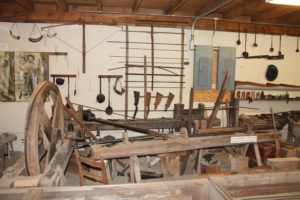
Here is a photo of the gunboring and rifling machines inside the Display Barn.
The Display Barn is where you can find the majority of the Gunsmithing/building tools and firearms. There are many different sized and shaped gun anvils/swage blocks to view up close, as well as various gunmaking tools for making molds for projectiles and other specialized items. The most interesting things that I saw were the barrel boring and rifling machines. Both of these machines and the rifles that were made with them are good examples of the combination of engineering and artistry of the Appalachian settlers. The gunboring machine is used to bore and ream the gun barrel after the barrel is made in the blacksmithing shop. The high spots inside the barrel are removed with a square-ended rod and then successively larger bits are used to ream out the full length of the barrel to the correct diameter for the caliber of the rifle or pistol. The gunboring machine is operated by a large hand cranked wheel that drives a pulley and belt system, which in turn makes the long bit/reamer spin rapidly. The gun barrel itself is attached to a weighted carriage that is self-driven into the path of the revolving reaming bit, thus enlarging the diameter of the hole in the barrel.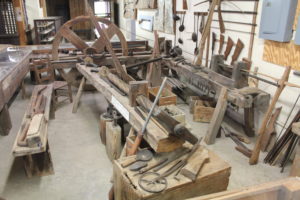
Here is an alternate view of the gunboring and rifling machines.
After the barrel is bored and reamed, the gunmaker would then rifle the barrel. The rifling machine cuts the spiraled grooves into the barrel. The machine consists of a hand carved spiraled rifling guide. On one end of the rifling guide is a revolving handle and attached to the other end of the guide is a saw-toothed rod that is as long as the guide itself. The rifling guide is pushed forward via the revolving handle. The guide then moves forward through a circular notched wooden block and the guide turns slowly. The saw-toothed rod, being attached to the guide, also turns slowly and is guided forward into the bore of the barrel, which is mounted and stationary, thus cutting a rifling groove on the inside of the barrel. Once the first groove is cut, the guide is taken out of the circular notched wooden block and moved one notch. Then the second rifling groove can be cut. Many rifle barrels had five rifling grooves, so this cutting process was repeated five times, creating five evenly spaced spiraled grooves all following the same twist rate as the rifling guide. The grooves were made deeper by applying thin paper shims under the saw teeth (making them protrude more) and repeating the cutting processes.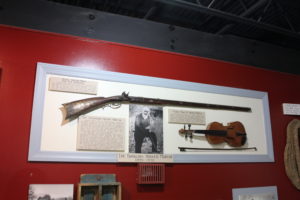
Shown above is a photo of Gunmaker Hacker Martin and a rifle he built for his son.
Another highlight for me was to see some of Hacker Martin’s rifles in person. Hacker Martin (1895-1970) was a Gunmaker from rural Upper East Tennessee. Hacker also operated a water-powered grist mill, was a blacksmith, a woodworker, toolmaker, farmer and he did all of the metal and stock work on his guns himself. Hacker’s rifles are very collectable and sought after by serious gun collectors. Other mountain gunsmiths to research and learn about are George Rice, William Beals, and Charles Bean to name just a few. Though a mountain rifle might be utilitarian in its use, they are still works of art and are masterfully crafted. The Museum of Appalachia had on display just about every tool that you would need to build a flintlock rifle from scratch; various saws and axes to fell the timber for the gun stock, log cabin barns to dry and age the wood in, a wealth of wood planes, chisels, hammers, shaving horses, forges, anvils and files. Besides some really gorgeous mountain rifles, there was an impressive collection of animal traps to capture everything from rabbits to grizzly bears so that you could stay well fed as you built your custom flintlock rifle! I would recommend the Foxfire Museum and the Museum of Appalachia to anyone who has an interest in history, homesteading, blacksmithing tools, guns or gunsmithing. I will always treasure the memories of this “gunmaker’s vacation” I had with my brother. I could see myself as the curator of a firearms museum. This trip gave me some great ideas!